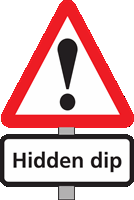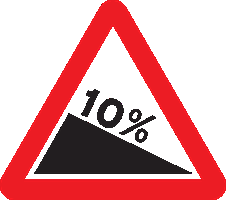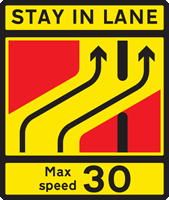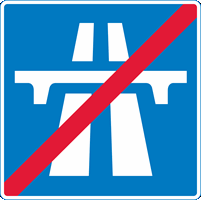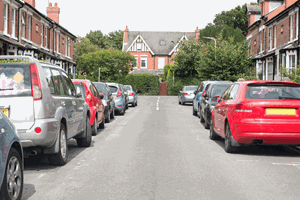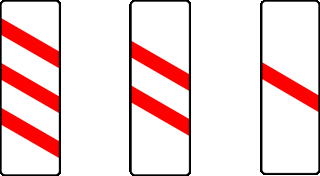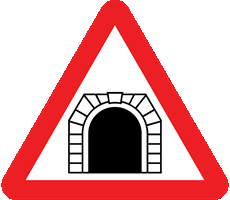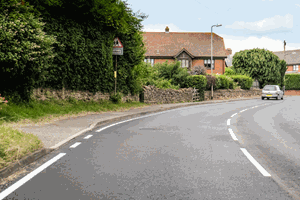You have 57 minutes to answer 50 multiple choice driving theory test questions. You need to answer at least 43 out of 50 questions correctly to pass. You can review your answer after each question or you can review all of your answers at the end of the test. Best of luck!
Test Quick View
Click on an answer to view the correct choice along with the explanation.
Correct Answer: B
Explanation: Tyre grip is greatly reduced in icy conditions. For this reason, you need to allow up to ten times the stopping distance you would allow on dry roads.
Explanation: Tyre grip is greatly reduced in icy conditions. For this reason, you need to allow up to ten times the stopping distance you would allow on dry roads.
2. You're waiting to come out of a side road. Why should you look carefully for motorcycles? Mark one answer
AB
C
D
Correct Answer: B
Explanation: If you're waiting to emerge from a side road, look carefully for motorcycles: they can be difficult to see. Be especially careful if there are parked vehicles or other obstructions restricting your view.
Explanation: If you're waiting to emerge from a side road, look carefully for motorcycles: they can be difficult to see. Be especially careful if there are parked vehicles or other obstructions restricting your view.
Correct Answer: A
Explanation: When following a large vehicle, keep well back. If you're too close, you won't be able to see the road ahead and the driver of the long vehicle might not be able to see you in their mirrors.
Explanation: When following a large vehicle, keep well back. If you're too close, you won't be able to see the road ahead and the driver of the long vehicle might not be able to see you in their mirrors.
Correct Answer: A
Explanation: You should give way to traffic already on the motorway. Where possible, traffic may move over to let you in, but don't force your way into the traffic stream. Traffic could be travelling at high speed, so try to match your speed to filter in without affecting the traffic flow.
Explanation: You should give way to traffic already on the motorway. Where possible, traffic may move over to let you in, but don't force your way into the traffic stream. Traffic could be travelling at high speed, so try to match your speed to filter in without affecting the traffic flow.
5. You're approaching a busy junction. What should you do when, at the last moment, you realise you're in the wrong lane? Mark one answer
AB
C
D
Correct Answer: A
Explanation: There are times when road markings are obscured by queuing traffic, or you're unsure which lane to use. If, at the last moment, you find you're in the wrong lane, don't cut across or bully other drivers to let you in. Follow the lane you're in and find somewhere safe to turn around and rejoin your route.
Explanation: There are times when road markings are obscured by queuing traffic, or you're unsure which lane to use. If, at the last moment, you find you're in the wrong lane, don't cut across or bully other drivers to let you in. Follow the lane you're in and find somewhere safe to turn around and rejoin your route.
Correct Answer: A
Explanation: You won't be able to see any hazards that might be hidden in the dip. As well as oncoming traffic the dip may conceal
- cyclists
- horse riders
- parked vehicles
- pedestrians
in the road.
Explanation: You won't be able to see any hazards that might be hidden in the dip. As well as oncoming traffic the dip may conceal
- cyclists
- horse riders
- parked vehicles
- pedestrians
in the road.
Correct Answer: B
Explanation: This sign gives you an early warning that the road ahead will slope downhill. Prepare to alter your speed and gear. Looking at the sign from left to right will show you whether the road slopes uphill or downhill.
Explanation: This sign gives you an early warning that the road ahead will slope downhill. Prepare to alter your speed and gear. Looking at the sign from left to right will show you whether the road slopes uphill or downhill.
Correct Answer: B
Explanation: If you use the right-hand lane in a contraflow system, you'll be travelling with no permanent barrier between you and the oncoming traffic. Observe speed limits and keep a good distance from the vehicle ahead.
Explanation: If you use the right-hand lane in a contraflow system, you'll be travelling with no permanent barrier between you and the oncoming traffic. Observe speed limits and keep a good distance from the vehicle ahead.
Correct Answer: D
Explanation: You might see this sign where traffic lights are out of order. Proceed with caution, as nobody has priority at the junction.
Explanation: You might see this sign where traffic lights are out of order. Proceed with caution, as nobody has priority at the junction.
Correct Answer: B
Explanation: When you leave the motorway, make sure that you check your speedometer. You may be going faster than you realise. Slow down and look for speed-limit signs.
Explanation: When you leave the motorway, make sure that you check your speedometer. You may be going faster than you realise. Slow down and look for speed-limit signs.
11. You've just passed these warning lights. What hazard would you expect to see next? Mark one answer

B
C
D
Correct Answer: B
Explanation: These lights warn that children may be crossing the road to a nearby school. Slow down so that you're ready to stop if necessary.
Explanation: These lights warn that children may be crossing the road to a nearby school. Slow down so that you're ready to stop if necessary.
Correct Answer: B
Explanation: Temporary restrictions on motorways are shown on signs that have flashing amber lights. At the end of the restriction, you'll see this sign without any flashing lights.
Explanation: Temporary restrictions on motorways are shown on signs that have flashing amber lights. At the end of the restriction, you'll see this sign without any flashing lights.
Correct Answer: A
Explanation: Learners might not have confidence when they first start to drive. Allow them plenty of room and don't react adversely to their hesitation. We all learn from experience, but new drivers will have had less practice in dealing with all the situations that might occur.
Explanation: Learners might not have confidence when they first start to drive. Allow them plenty of room and don't react adversely to their hesitation. We all learn from experience, but new drivers will have had less practice in dealing with all the situations that might occur.
14. You keep well back while waiting to overtake a large vehicle. What should you do if a car moves into the gap? Mark one answer
AB
C
D
Correct Answer: A
Explanation: Sometimes your separation distance is shortened by a driver moving into the gap you've allowed. When this happens, react positively, stay calm and drop further back to re-establish a safe following distance.
Explanation: Sometimes your separation distance is shortened by a driver moving into the gap you've allowed. When this happens, react positively, stay calm and drop further back to re-establish a safe following distance.
15. A horse rider is in the left-hand lane approaching a roundabout. Where should you expect the rider to go? Mark one answer
AB
C
D
Correct Answer: A
Explanation: Horses and their riders move more slowly than other road users. They might not have time to cut across heavy traffic to take up a position in the right-hand lane. For this reason, a horse and rider may approach a roundabout in the left-hand lane even though they're turning right.
Explanation: Horses and their riders move more slowly than other road users. They might not have time to cut across heavy traffic to take up a position in the right-hand lane. For this reason, a horse and rider may approach a roundabout in the left-hand lane even though they're turning right.
16. You've just gone through deep water. What should you do to make sure your brakes are working properly? Mark one answer
AB
C
D
Correct Answer: C
Explanation: Water on the brakes will act as a lubricant, causing them to work less efficiently. Using the brakes lightly as you go along will quickly dry them out.
Explanation: Water on the brakes will act as a lubricant, causing them to work less efficiently. Using the brakes lightly as you go along will quickly dry them out.

B
C
D
Correct Answer: C
Explanation: Yellow 'box junctions' like this are often used where it's busy. Their purpose is to keep the junction clear for crossing traffic. Don't enter the painted area unless your exit is clear. The one exception is when you're turning right and are only prevented from doing so by oncoming traffic or by other vehicles waiting to turn right.
Explanation: Yellow 'box junctions' like this are often used where it's busy. Their purpose is to keep the junction clear for crossing traffic. Don't enter the painted area unless your exit is clear. The one exception is when you're turning right and are only prevented from doing so by oncoming traffic or by other vehicles waiting to turn right.
Correct Answer: C
Explanation: Puffin crossings have infra-red sensors that detect when pedestrians are crossing and hold the red traffic signal until the crossing is clear. The use of a sensor means there's no flashing amber phase as there is with a pelican crossing.
Explanation: Puffin crossings have infra-red sensors that detect when pedestrians are crossing and hold the red traffic signal until the crossing is clear. The use of a sensor means there's no flashing amber phase as there is with a pelican crossing.
Correct Answer: A
Explanation: On roads where there are many parked vehicles, you might not be able to see children between parked cars and they may run out into the road without looking.
Explanation: On roads where there are many parked vehicles, you might not be able to see children between parked cars and they may run out into the road without looking.
A
B
C
D
B
C
D
Correct Answer: C
Explanation: Take care when using single-track roads. It can be difficult to see around bends, because of hedges or fences, so expect to meet oncoming vehicles. Drive carefully and be ready to pull into or stop opposite a passing place, where you can pass each other safely.
Explanation: Take care when using single-track roads. It can be difficult to see around bends, because of hedges or fences, so expect to meet oncoming vehicles. Drive carefully and be ready to pull into or stop opposite a passing place, where you can pass each other safely.
Correct Answer: D
Explanation: You must stop if overhead gantry signs show flashing red lights above every lane on the motorway. If any of the other lanes doesn't show flashing red lights or a red cross, you may move into that lane and continue if it's safe to do so.
Explanation: You must stop if overhead gantry signs show flashing red lights above every lane on the motorway. If any of the other lanes doesn't show flashing red lights or a red cross, you may move into that lane and continue if it's safe to do so.
Correct Answer: A
Explanation: This road marking means you should give way to traffic on the main road. It might not be used at junctions where there isn't much traffic. However, if there's a double broken line across the junction, the 'give way' rules still apply.
Explanation: This road marking means you should give way to traffic on the main road. It might not be used at junctions where there isn't much traffic. However, if there's a double broken line across the junction, the 'give way' rules still apply.
Correct Answer: A
Explanation: If there's a bend just before a level crossing, you may not be able to see the level-crossing barriers or waiting traffic. These signs give you an early warning that you may find these hazards just around the bend.
Explanation: If there's a bend just before a level crossing, you may not be able to see the level-crossing barriers or waiting traffic. These signs give you an early warning that you may find these hazards just around the bend.
24. You see a pedestrian with a dog wearing a yellow or burgundy coat. What does this indicate? Mark one answer
AB
C
D
Correct Answer: C
Explanation: Dogs trained to help deaf people have a yellow or burgundy coat. If you see one, you should take extra care, as the pedestrian may not be aware of vehicles approaching.
Explanation: Dogs trained to help deaf people have a yellow or burgundy coat. If you see one, you should take extra care, as the pedestrian may not be aware of vehicles approaching.
25. A casualty isn't breathing normally. Chest compressions should be given. At what rate? Mark one answer
AB
C
D
Correct Answer: B
Explanation: If a casualty isn't breathing normally, chest compressions may be needed to maintain circulation. Place two hands on the centre of the chest and press down hard and fast - around 5-6 centimetres and about twice a second.
Explanation: If a casualty isn't breathing normally, chest compressions may be needed to maintain circulation. Place two hands on the centre of the chest and press down hard and fast - around 5-6 centimetres and about twice a second.
Correct Answer: D
Explanation: When approaching a tunnel, switch on your dipped headlights. Be aware that your eyes might need to adjust to the sudden darkness. You may need to reduce your speed.
Explanation: When approaching a tunnel, switch on your dipped headlights. Be aware that your eyes might need to adjust to the sudden darkness. You may need to reduce your speed.
27. At an incident, it's important to look after any casualties. What should you do with them when the area is safe? Mark one answer
AB
C
D
Correct Answer: C
Explanation: When the area is safe and there's no danger from other traffic or fire, it's better not to move casualties. Moving them may cause further injury.
Explanation: When the area is safe and there's no danger from other traffic or fire, it's better not to move casualties. Moving them may cause further injury.
Correct Answer: C
Explanation: You should carry out frequent checks on all fluid levels but particularly brake fluid. As the brake pads or shoes wear down, the brake fluid level will drop. If it drops below the minimum mark on the fluid reservoir, air could enter the hydraulic system and lead to a loss of braking efficiency or even complete brake failure.
Explanation: You should carry out frequent checks on all fluid levels but particularly brake fluid. As the brake pads or shoes wear down, the brake fluid level will drop. If it drops below the minimum mark on the fluid reservoir, air could enter the hydraulic system and lead to a loss of braking efficiency or even complete brake failure.
29. You're turning left on a slippery road. What should you do if the back of your vehicle slides to the right? Mark one answer
AB
C
D
Correct Answer: D
Explanation: To correct a skid, you need to steer into it. However, be careful not to overcorrect with too much steering, as this may cause a skid in the opposite direction. Skids don't just happen; they're caused - usually by the driver. Factors increasing the likelihood of a skid include the condition of the vehicle (especially its tyres) and the road and weather conditions.
Explanation: To correct a skid, you need to steer into it. However, be careful not to overcorrect with too much steering, as this may cause a skid in the opposite direction. Skids don't just happen; they're caused - usually by the driver. Factors increasing the likelihood of a skid include the condition of the vehicle (especially its tyres) and the road and weather conditions.
Correct Answer: D
Explanation: Turning the wheels towards the kerb will allow them to act as a chock, preventing any forward movement of the vehicle. It will also help to leave your car in gear, or select 'Park' if you have an automatic.
Explanation: Turning the wheels towards the kerb will allow them to act as a chock, preventing any forward movement of the vehicle. It will also help to leave your car in gear, or select 'Park' if you have an automatic.
31. You're driving in a built-up area that has traffic-calming measures. What should you do when you approach a road hump? Mark one answer
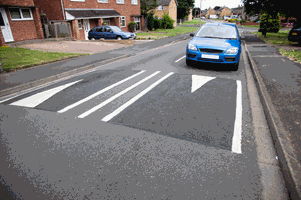
B
C
D
Correct Answer: A
Explanation: Many towns have road humps as part of traffic-calming measures, designed to slow down traffic. Reduce your speed when driving over them. If you go too fast, you could lose control or damage your car. Look out for pedestrians or cyclists while you're driving in these areas.
Explanation: Many towns have road humps as part of traffic-calming measures, designed to slow down traffic. Reduce your speed when driving over them. If you go too fast, you could lose control or damage your car. Look out for pedestrians or cyclists while you're driving in these areas.
Correct Answer: B
Explanation: The continuous white line shows the edge of the carriageway. It can be especially useful when visibility is restricted, such as at night or in bad weather. It's discontinued in some places; for example, at junctions, lay-bys, entrances or other openings.
Explanation: The continuous white line shows the edge of the carriageway. It can be especially useful when visibility is restricted, such as at night or in bad weather. It's discontinued in some places; for example, at junctions, lay-bys, entrances or other openings.
33. You're driving past a line of parked cars. You notice a ball bouncing out into the road ahead. What should you do? Mark one answer
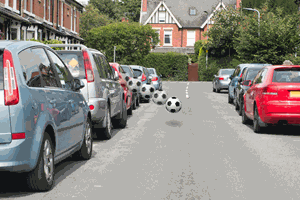
B
C
D
Correct Answer: C
Explanation: Beware of children playing in the street and running out into the road. If a ball bounces out from the pavement, slow down and be prepared to stop. Don't encourage anyone to retrieve it. Other road users may not see your signal and you might lead a child into a dangerous situation.
Explanation: Beware of children playing in the street and running out into the road. If a ball bounces out from the pavement, slow down and be prepared to stop. Don't encourage anyone to retrieve it. Other road users may not see your signal and you might lead a child into a dangerous situation.
34. You're driving on a motorway and have to slow down quickly due to a hazard ahead. How can you warn drivers behind of the hazard? Mark one answer
AB
C
D
Correct Answer: C
Explanation: Using your hazard warning lights, as well as your brake lights, will give following traffic an extra warning of the problem ahead. Only use them for long enough for your warning to be seen.
Explanation: Using your hazard warning lights, as well as your brake lights, will give following traffic an extra warning of the problem ahead. Only use them for long enough for your warning to be seen.
35. A cycle lane, marked by a solid white line, is in operation. What does this mean for car drivers? Mark one answer
AB
C
D
Correct Answer: D
Explanation: Leave the lane free for cyclists. At other times, when the lane isn't in operation, you should still be aware that there may be cyclists about. Give them plenty of room as you pass and allow for their movement from side to side, especially in windy weather or on a bumpy road.
Explanation: Leave the lane free for cyclists. At other times, when the lane isn't in operation, you should still be aware that there may be cyclists about. Give them plenty of room as you pass and allow for their movement from side to side, especially in windy weather or on a bumpy road.
Correct Answer: B
Explanation: It's easy to be distracted. Planning your journey before you set off is important. A few sensible precautions are to tune your radio to stations in your area of travel, take planned breaks, and plan your route. Except for emergencies, it's illegal to use a hand-held mobile phone while driving. Even using a hands-free kit can severely distract your attention.
Explanation: It's easy to be distracted. Planning your journey before you set off is important. A few sensible precautions are to tune your radio to stations in your area of travel, take planned breaks, and plan your route. Except for emergencies, it's illegal to use a hand-held mobile phone while driving. Even using a hands-free kit can severely distract your attention.
37. Anti-lock brakes reduce the chances of skidding. When is this particularly important? Mark one answer
AB
C
D
Correct Answer: B
Explanation: The anti-lock braking system (ABS) will operate when the brakes have been applied harshly and the wheels are about to lock, such as during an emergency. ABS will reduce the likelihood of your car skidding, but it isn't a substitute for safe and responsible driving.
Explanation: The anti-lock braking system (ABS) will operate when the brakes have been applied harshly and the wheels are about to lock, such as during an emergency. ABS will reduce the likelihood of your car skidding, but it isn't a substitute for safe and responsible driving.
38. You're driving along this road. The driver on the left is reversing from a driveway. What should you do? Mark one answer
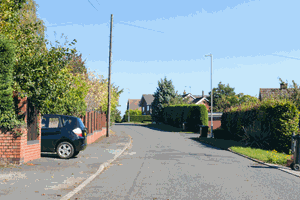
B
C
D
Correct Answer: C
Explanation: White lights at the rear of a car show that the driver has selected reverse gear. Sound your horn to warn the other driver of your presence, and reduce your speed as a precaution.
Explanation: White lights at the rear of a car show that the driver has selected reverse gear. Sound your horn to warn the other driver of your presence, and reduce your speed as a precaution.
39. Your doctor has given you a course of medicine. Why should you ask how it will affect you? Mark one answer
AB
C
D
Correct Answer: B
Explanation: Always check the label or information leaflet for any medication you take. The medicine might affect your driving. If you aren't sure, ask your doctor or pharmacist.
Explanation: Always check the label or information leaflet for any medication you take. The medicine might affect your driving. If you aren't sure, ask your doctor or pharmacist.
40. You find that you need glasses to read vehicle number plates at the required distance. When must you wear them? Mark one answer
AB
C
D
Correct Answer: A
Explanation: Have your eyesight tested before you start your practical training. Then, throughout your driving life, have checks periodically, as your vision may change.
Explanation: Have your eyesight tested before you start your practical training. Then, throughout your driving life, have checks periodically, as your vision may change.
Correct Answer: A
Explanation: Having tyres correctly inflated and in good condition will ensure they have maximum grip on the road; how well your tyres grip the road has a significant effect on your car's stopping distance.
Explanation: Having tyres correctly inflated and in good condition will ensure they have maximum grip on the road; how well your tyres grip the road has a significant effect on your car's stopping distance.
42. Why is it particularly important to carry out a check on your vehicle before making a long motorway journey? Mark one answer
AB
C
D
Correct Answer: A
Explanation: Before you start your journey, make sure that your vehicle can cope with the demands of high-speed driving. You should check a number of things, the main ones being oil, water and tyres. You also need to plan rest stops if you're making a long journey.
Explanation: Before you start your journey, make sure that your vehicle can cope with the demands of high-speed driving. You should check a number of things, the main ones being oil, water and tyres. You also need to plan rest stops if you're making a long journey.
Correct Answer: D
Explanation: It's easy to lose your way in an unfamiliar area. If you need to check a map or ask for directions, first find a safe place to stop.
Explanation: It's easy to lose your way in an unfamiliar area. If you need to check a map or ask for directions, first find a safe place to stop.
Correct Answer: D
Explanation: Hazard warning lights are an important safety feature and should be used if you've broken down and are causing an obstruction. Don't use them as an excuse to park illegally. You may also use them on motorways to warn traffic behind you of danger ahead.
Explanation: Hazard warning lights are an important safety feature and should be used if you've broken down and are causing an obstruction. Don't use them as an excuse to park illegally. You may also use them on motorways to warn traffic behind you of danger ahead.
45. The road outside this school is marked with yellow zigzag lines. What do these lines mean? Mark one answer
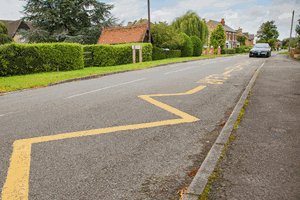
B
C
D
Correct Answer: D
Explanation: Parking here would block other road users' view of the school entrance and would endanger the lives of children on their way to and from school.
Explanation: Parking here would block other road users' view of the school entrance and would endanger the lives of children on their way to and from school.
Correct Answer: A
Explanation: The cost of insurance varies with your age and how long you've been driving. Usually, the younger you are, the more expensive it is, especially if you're under 25. Pass Plus provides additional training to newly qualified drivers. The scheme is recognised by many insurance companies, and taking this extra training could give you reduced insurance premiums, as well as improving your skills and experience.
Explanation: The cost of insurance varies with your age and how long you've been driving. Usually, the younger you are, the more expensive it is, especially if you're under 25. Pass Plus provides additional training to newly qualified drivers. The scheme is recognised by many insurance companies, and taking this extra training could give you reduced insurance premiums, as well as improving your skills and experience.
47. You're driving a slow-moving vehicle on a narrow, winding road. What should you do? Mark one answer
AB
C
D
Correct Answer: C
Explanation: If you're driving a slow-moving vehicle along a narrow road, try not to hold up faster traffic. If you see vehicles following behind, pull over in a safe place and let the traffic pass before continuing. Don't wave other traffic past - this could be dangerous if you or they haven't seen any hazard that's hidden from view.
Explanation: If you're driving a slow-moving vehicle along a narrow road, try not to hold up faster traffic. If you see vehicles following behind, pull over in a safe place and let the traffic pass before continuing. Don't wave other traffic past - this could be dangerous if you or they haven't seen any hazard that's hidden from view.
Correct Answer: D
Explanation: A broken-down vehicle in a tunnel can cause serious congestion and danger to other road users. If your vehicle breaks down, get help without delay. Switch on your hazard warning lights, then go to an emergency telephone to call for help.
Explanation: A broken-down vehicle in a tunnel can cause serious congestion and danger to other road users. If your vehicle breaks down, get help without delay. Switch on your hazard warning lights, then go to an emergency telephone to call for help.
49. It's a very windy day and you're about to overtake a cyclist. What should you do? Mark one answer
AB
C
D
Correct Answer: A
Explanation: Cyclists, and motorcyclists, are very vulnerable in high winds. They can easily be blown well off course and veer into your path. Always allow plenty of room when overtaking them. Passing too close could cause a draught and unbalance the rider.
Explanation: Cyclists, and motorcyclists, are very vulnerable in high winds. They can easily be blown well off course and veer into your path. Always allow plenty of room when overtaking them. Passing too close could cause a draught and unbalance the rider.
50. You're braking on a wet road. Your vehicle begins to skid. It doesn't have anti-lock brakes. What's the first thing you should do? Mark one answer
AB
C
D
Correct Answer: D
Explanation: If the skid has been caused by braking too hard for the conditions, release the brake. You may then need to reapply and release the brake again. You may need to do this a number of times. This will allow the wheels to turn and so some steering should also be possible.
Explanation: If the skid has been caused by braking too hard for the conditions, release the brake. You may then need to reapply and release the brake again. You may need to do this a number of times. This will allow the wheels to turn and so some steering should also be possible.



